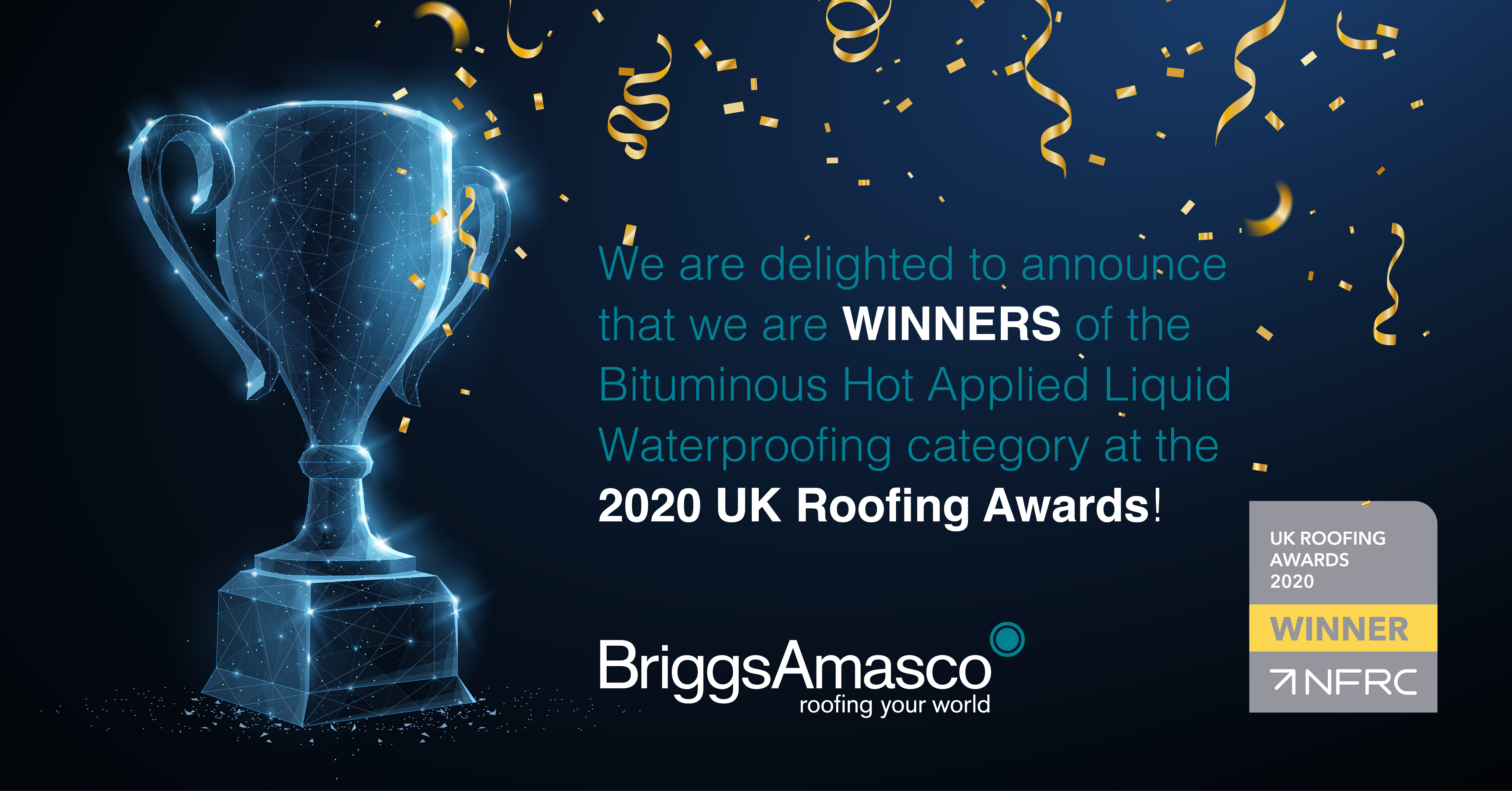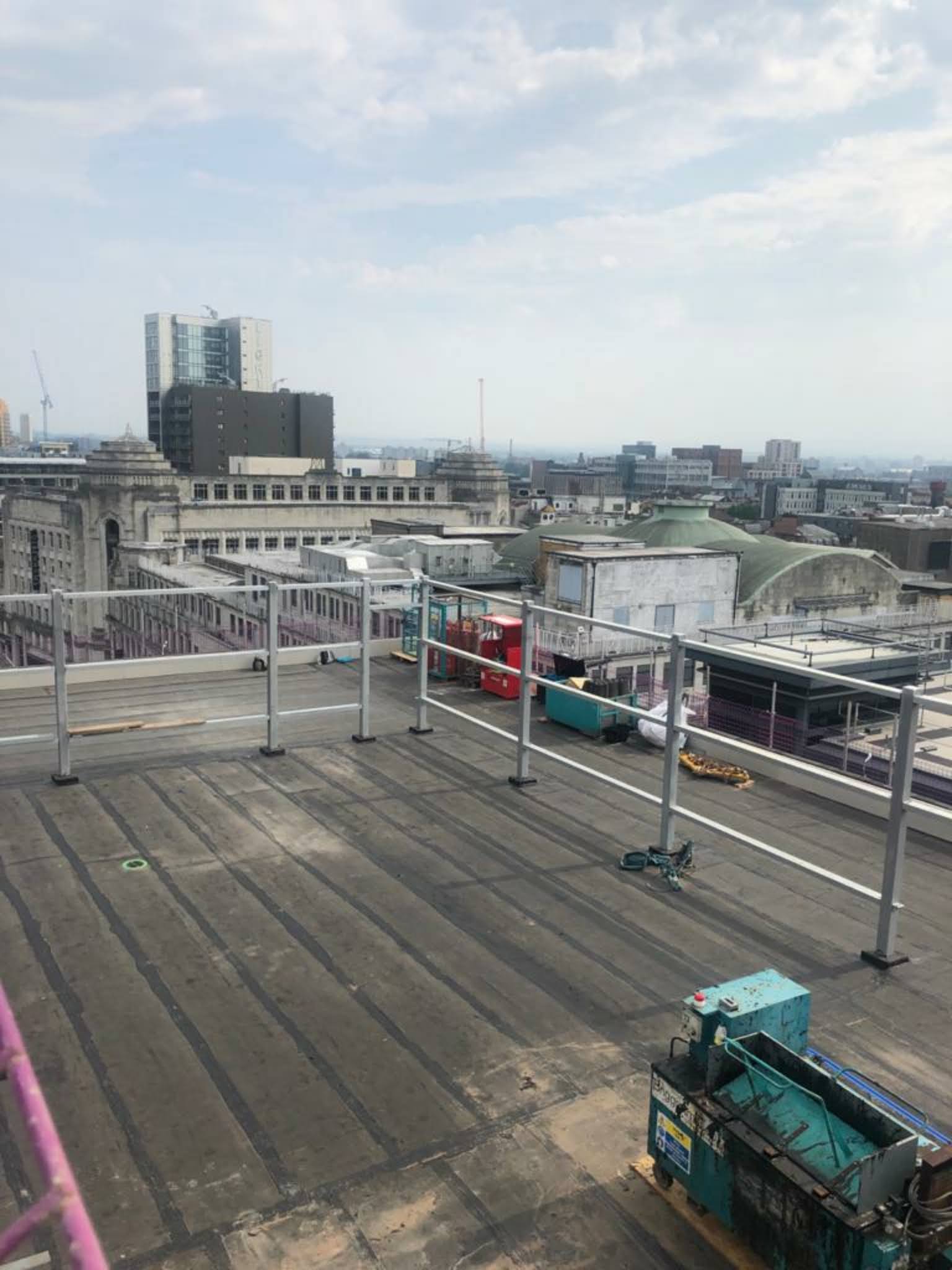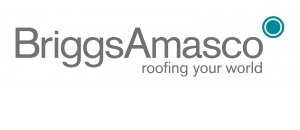NFRC Gold Award 2020
BriggsAmasco is pleased to announce that we have received the Gold Award in the 2020 Health & Safety in Roofing Awards Scheme from NFRC.
NFRC Winner!
BriggsAmasco Triumphs at Acclaimed NFRC Awards
BriggsAmasco was among the winners at the 2020 National Federation of Roofing Contractors (NFRC) awards thanks to its exceptional waterproofing work on a state-of-the-art sports centre.
The company took the honours in the contest’s Bituminous Hot Applied Liquid Waterproofing category. It followed Briggs’ installation of waterproofing and finishes across a 3,500m2 area at Brighton College’s new sports and science centre. The multi-application project, carried out in 2019, included providing a watertight seal for a main roof, winter garden and car park. The £38m centre will provide a world-class training environment for students, making a transformational difference to school life for generations to come.
Speaking of the company’s award, Dave Maginnis, Managing Director at BriggsAmasco, said: “This is brilliant news. The NFRC awards are acclaimed throughout the roofing industry and remain an annual highlight. We were up against some incredibly tough competition from across the country. To have triumphed above all-comers in a very competitive category speaks volumes for the skills of our installation team. Their experience and dedication, along with the exceptional hard work from everyone across all levels of BriggsAmasco’s business, are what makes this company great. I thank every one of you for ensuring our name is perpetually associated with quality and success.”
BriggsAmasco is to be awarded with a trophy commemorating its NFRC success. Dave Maginnis said he hoped the award would lead to further recognition later this year. “We are proud of our everyday achievements, so to have them verified by independent experts is particularly gratifying. I’m hope this won’t be our only cause for celebration as 2021 progresses.”

Safety Award from McAlpine
Two of our employees from our Manchester branch have been awarded a Safety Award from McAlpines whilst working at Embankment in Manchester. Whilst on the roof they discovered other trades materials unsecured and with high winds forecast they secured them.
Shouting it from the Rooftops
Codes of practice throughout all strands of the construction industry are under constant review to reflect changes in legislation or improve working processes. But in the haste to deliver an increasing volume of building projects to ever-tighter deadlines, are revised standards being overlooked in the charge for the finish line, or do they generally go unnoticed? Steve Ricketts, Branch Manager at BriggsAmasco’s Manchester headquarters, highlights a code of practice change that will serve the roofing sector well – if it is adhered to.
Introduced in December 2018, the BS 6229:2018 code of practice, which describes best guidance in the design, construction, care and maintenance of a flat or curved roof with a pitch not greater than 10 degrees, has a few distinct changes to its original form. The headline amendment as far as specifiers and installers are concerned is likely to be the advice that states flat roofs should be designed with a fall of 1:40 to ensure a minimum 1:80 fall is achieved once the roof and gutter soles are completed. The new guidance, which was four years in the devising, drew a line in the sand. Its evolution is aimed to address the serious issue of flat roof ponding. But as someone who is tasked with assessing roofs across UK construction sites on a regular basis, I’m inclined to think large-scale adherence to the new guidance is lacking, particularly when looking at inverted roof solutions such as hot melt where the system is BBA-certified for a zero falls or flat roof deck.
Dealing with dishing issues
Construction-wise, flat in terms of a roof doesn’t mean totally flat. Concrete decks often have deflections or back falls that form dishes in which water can collect. The revised code of practice acknowledged this issue by putting the onus on designing-out the potential for ponding prior to construction. For inverted roofs where this hasn’t taken place and a concrete roof has acquired negative falls as a consequence, another solution is required. Previously, the simplest way to correct a fall-less roof would be to lay the concrete deck, wait for it to rain and see where the water ponds. In severe cases, additional outlets would then be installed in the affected areas to ensure the water is drained away. But as much of the roofing work carried out by BriggsAmasco in the past couple of years has involved high-rise residential towers, there isn’t the freedom to be selective when installing outlets. This, therefore, negates the option.
Fortunately, there are a couple of other proven solutions when it comes to concrete inverted roofs which fail to meet the revised BS 6229 standard. One method involves laying a screed across an entire roof to form the omitted fall. Flexiscreed or Permascreed is ideal for this action, which in installation terms means starting with a minimum depth of 10mm and ‘falling’ towards an outlet, depending on the shape and size of the roof containing the falls. An alternative option is to infill the ponding indentations and wait for rainfall to evidence where the water lies. The surface can then be levelled back to zero falls. This is a less-costly method and guarantee-wise, will generally satisfy most flat roofing requirements.
Hot melt roofs tend to be the simplest to correct when it comes to inverted flat roofs and the potential for ponding. On surfaces where there is only a small deflection, for example, the hot melt can be quickly and easily built-up to the same level as the remaining roof area. During summer when rainfall isn’t as prevalent, a roof survey is often the quickest and most effective way to confirm that a hot melt roof has been levelled to the required standard.
I believe the revised code of practice is a definite and positive step to reducing issues with ponding on flat roofs, which can have damaging consequences for buildings – if not treated correctly – over time. The fact that a prevalence of inverted roofs are still being built to the 2003 guidance suggests to me a lack of awareness of the revised advice among the building industry as a whole. If standards are to improve and assure our buildings are long-term protected against the elements, perhaps it’s time the roofing industry itself did more to promote the best practice outlined in BS 6229:2018. Metaphorically at least, shouting from the roof tops about this new level of guidance could be what it takes to bring about the change it designs to inspire.


From Potato picker to Operations Director
He soon found a job with WM Briggs & Sons Ltd of Dundee (later BriggsAmasco) in its Aberdeen contracting office and was to spend the next 40 years with them.
During this time with BriggsAmasco Cyril Mcfarlane Caseby was known as “Mac”. He was the Operations Director for Scotland in the late 80’s early/mid 90’s. and retired around 1995.
BriggsAmasco supports campaign to keep UK staff on track with workplace learning curve
Learning at Work Week is an annual initiative designed to highlight the importance of continued education and development in the UK workplace.
The scheme, which is run by Campaign for Learning and takes place from October 5th to 11th, is driven by the ethos that ‘effective learning leads to change, development and the desire to learn more’. It’s a value that is shared by leading commercial roofing contractor, BriggsAmasco, which employs a number of apprentices and is committed to supplying the tools to support professionally-led staff training programmes.
Steph Palmer, Training Officer at BriggsAmasco, said: “Initiatives such as Learning at Work Week are really important. They highlight the fact that learning is for everyone, no matter an employee’s age or experience. The construction industry is continually evolving, therefore it is vital companies and their staff are able to keep abreast of new products, systems and practices.”
BriggsAmasco currently employs nine apprentices, seven of which will shortly achieve an NVQ Level 2 in roofing, a qualification that leads to a CSCS ‘blue card’ and allows the holder access to building sites across the UK. The additional trainee is gaining hands-on experience whilst working towards a quantity surveying degree apprenticeship at Leeds University, whilst another is serving an SVQ Level 3 Procurement apprenticeship.
The company is also enrolling more experienced staff on the NFRC’s RoofCERT scheme. Aimed at roofers with a minimum of three years in the industry, upon completion candidates will gain a national roofing accreditation as a visible means of their skills and experience.
As well as helping advance employees’ professional advancement, in 2017 BriggsAmasco implemented a programme related to personal wellbeing. Its mental health awareness training, which is due to be rolled out across the entire company, will help staff recognise signs of mental stress symptoms in themselves and colleagues.
With the coronavirus crisis continuing to have a devastating effect on the UK economy as well as people’s health, the need to take matters of the mind more seriously in relation to employees is gaining increasing acceptance throughout the building trade as a whole.
BriggsAmasco is also exploring the idea of introducing a ‘psychometric tools’ programme, a character analysis initiative to help staff gain a better understanding of each other in order to create a happier, more productive working environment.
Steph Palmer said the company’s mind awareness programmes had been well received by staff, who had bought into the idea that work could be mentally and physically challenging. “The feedback has been excellent,” she said. “The first stage of the programme involved our directors and branch managers gaining a mental health first aid qualification. The next phase will see us roll this out to all our operatives around the country. The reaction from staff has been one of pleasant surprise, with a general census being that mental health wasn’t necessarily something they’d thought about before, but were now a lot more thoughtful in their responses to mind-related issues.”
For more information on Learning at Work Week, visit: www.campaign-for-learning.org.uk




